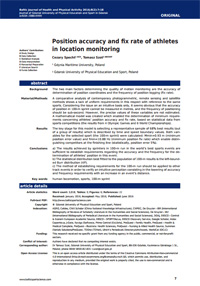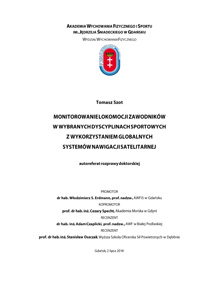Position accuracy and fix rate of athletes in location monitoring
Dokładność i częstotliwość określenia położenia sportowca podczas monitoringu położenia

Specht C, Szot T (2016)
- Abstract The two main factors determining the quality of motion monitoring are the accuracy of determination of position coordinates and the frequency of position logging (fix rate). A comparative analysis of contemporary photogrammetric, remote sensing and satellite methods shows a lack of uniform requirements in this respect, in reference to the same sports. Considering the issue on the intuitive basis only, it seems obvious that the accuracy of position in the 100-m sprint cannot be measured in metres, and the frequency of positioning should be sub-second. However, the precise values of these variables are not estimated. A mathematical model was created which enabled the determination of minimum requirements concerning athletes’ position accuracy and fix rate, based on statistical data from sports competitions (the results from 4 Olympic Games and 6 World Championships). The key stage for this model is selecting a representative population of 68% best results (out of a group of results) which is described by time and speed boundary values. Both variables for the selected sport (the 100-m sprint) were calculated: Mmin=0.93 m (minimum position error value) and fmin=10.88 Hz (minimum position fix rate) which enable distinguishing competitors at the finishing line (statistically, position error 5%). Keywords human locomotion, sports, 100-m sprint
- Streszczenie Dwoma głównymi czynnikami wpływającymi na jakość monitorowania ruchu są: dokładność oszacowania współrzędnych pozycji i częstotliwość jej ustalenia. Studium literatury wykazało jednakże brak jednolitych wymagań w tym zakresie, w odniesieniu do tych samych dyscyplin sportowych. W ujęciu intuicyjnym, oczywistym wydaje się, że dokładność monitorowania w biegu na 100 m nie może być mierzona w metrach, przy sub-sekundowej częstotliwości. Zaproponowano model matematyczny umożliwiający określenie minimalnych wymagań w zakresie dokładności i częstotliwości określenia położenia zawodnika, w oparciu o dane statystyczne pochodzące z zawodów sportowych (wyniki 4 Igrzysk Olimpijskich oraz 6 zawodów rangi Mistrzostw Świata). Kluczowym etapem w tym modelu jest wybór reprezentatywnej populacji 68% najlepszych wyników (spośród wszystkich), a następnie wyznaczenie wartości granicznych czasu i prędkości. Obie zmienne dla badanej konkurencji (sprint 100 m) obliczono jako: Mmin=0.93 m (minimalna dokładność ustalenia pozycji), fmin=10.88 Hz (minimalna częstotliwość ustalenia pozycji) i umożliwiają one rozróżnienie zawodników na linii mety (statystycznie, z błędem pozycji 5%). Słowa kluczowe lokomocja człowieka, sport, biegi krótkie, sprint na 100 m
- Pobierz plik PDF/download PDF file
 (pełny tekst/full article) (pełny tekst/full article)
|
Monitorowanie lokomocji zawodników w wybranych dyscyplinach sportowych z wykorzystaniem globalnych systemów nawigacji satelitarnej (dysertacja doktorska)
Monitoring of athletes’ locomotion in selected sports with the use of global navigation satellite systems (PhD thesis)

Szot T (2014)
- Streszczenie Dysertacja podejmuje dwa problemy badawcze. Pierwszym z nich jest brak jednolitych, uniwersalnych wymagań dokładnościowych i częstotliwościowych względem narzędzi oraz systemów pomocnych do monitorowania lokomocji sportowca (bez względu na sposób, w jaki pozyskują informację o jego położeniu), drugim – dopasowanie metod opartych na globalnych systemach nawigacji satelitarnej (GNSS) do uniwersalnych wymagań, o których wspomniano wyżej. W części teoretycznej pracy przedstawiono: istotę lokomocji, charakterystykę GNSS, przegląd piśmiennictwa w obszarze monitorowania lokomocji zawodnika na arenie sportowej oraz wieloaspektowość problemu monitorowania lokomocji wraz z odpowiednimi miarami położenia. Część praktyczna zawiera: koncepcję i metodykę badań, wyjaśnienie metody wyznaczenia dokładności i częstotliwości określenia współrzędnych pozycji, opis i wyniki statycznych oraz kinematycznych badań pilotażowych (dzięki którym dokonano podziału wśród odbiorników nawigacji satelitarnej), a także opis i wyniki badań weryfikujących przedstawioną metodę (wybór jednej z analizowanych konkurencji i dopasowanie do niej odbiornika). Przedstawione szerokie możliwości wnioskowania w obszarze lokomocji zawodników pozwoliły potwierdzić słuszność postawionej hipotezy, że odpowiednio częste i dokładne monitorowanie może udoskonalić proces treningowy. W pracy zawarto: 32 tabele, 80 rycin, 24 załączniki, 103 pozycje piśmiennictwa (w tym 73 angielskojęzyczne) oraz 32 źródła on-line.
- Abstract This paper discusses two research problems: (1) a lack of uniform, universal accuracy and frequency requirements concerning tools and systems facilitating the monitoring of athletes’ locomotion (irrespective of a method used to collect information about their position), and (2) the adjustment of methods based on global navigation satellite systems (GNSS) to the above-said universal requirements. The theoretical part of the paper presents: the nature of locomotion, the characteristic of GNSS, the review of literature on the monitoring of athletes’ locomotion at sports venues, and the multifaceted nature of locomotion monitoring, together with appropriate measures of location. The practical part includes: (1) the concept and methodology of research, (2) the explanation of the method of determining the accuracy and frequency of specifying location coordinates, (3) the description and results of static and dynamic pilot study (thanks to which satellite navigation receivers were classified), (4) the description and results of research verifying the method presented (the selection of one of the sports under analysis and matching a receiver with it). A wide range of inference options in the area of athletes’ locomotion made it possible to vindicate the hypothesis that sufficiently frequent and accurate monitoring may improve the training process. The paper contains: 32 tables, 80 illustrations, 24 appendixes, 103 reference titles (including 73 in English) and 32 online sources.
- Pobierz plik PDF/download PDF file
 (autoreferat/summary) (autoreferat/summary)
|













 Odbiorniki GNSS (GPS i in.) w sporcie i rekreacji
Odbiorniki GNSS (GPS i in.) w sporcie i rekreacji  Monitorowanie lokomocji sportowców
Monitorowanie lokomocji sportowców  Pozostałe
Pozostałe 